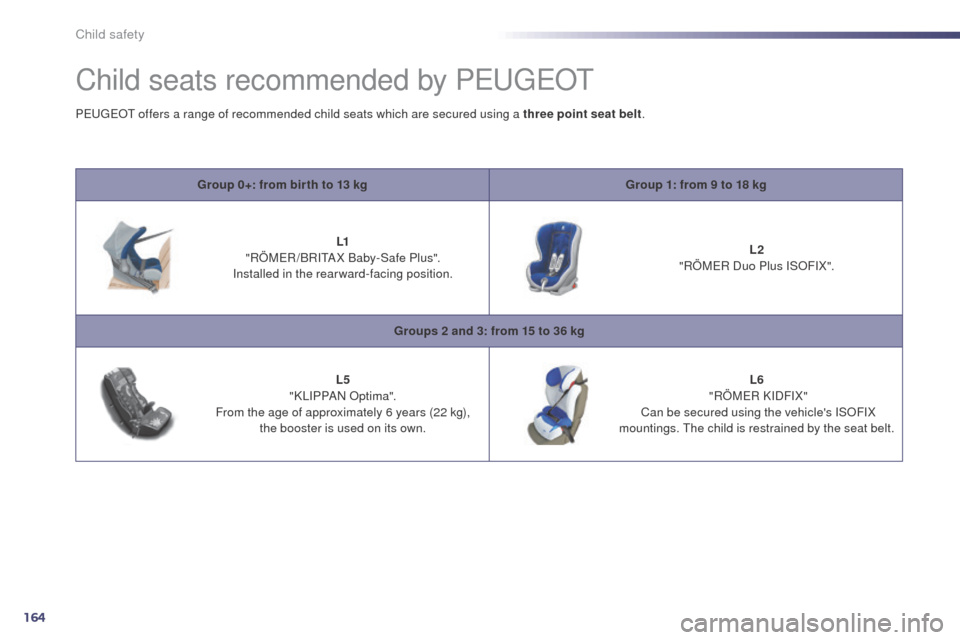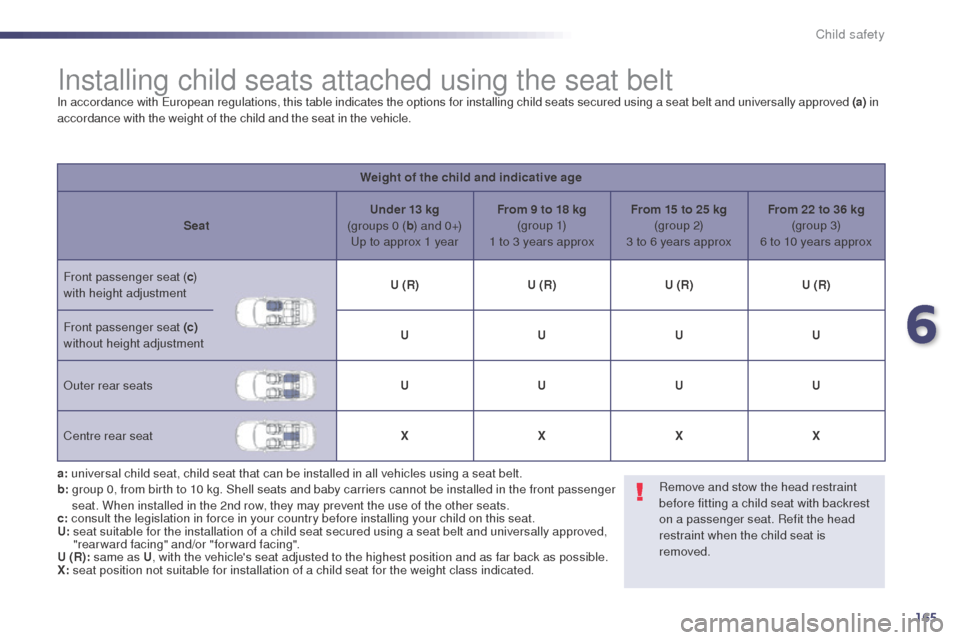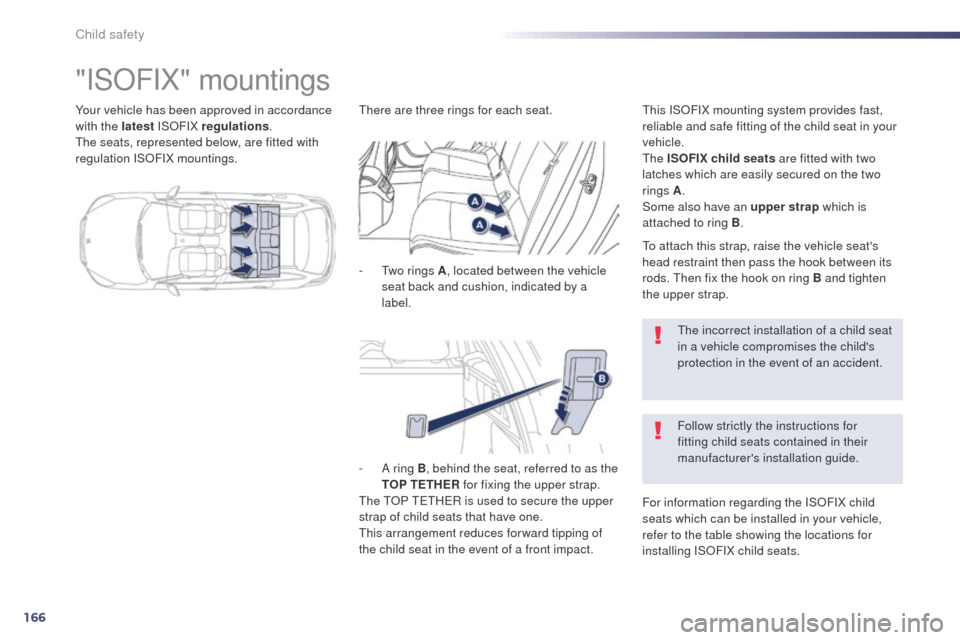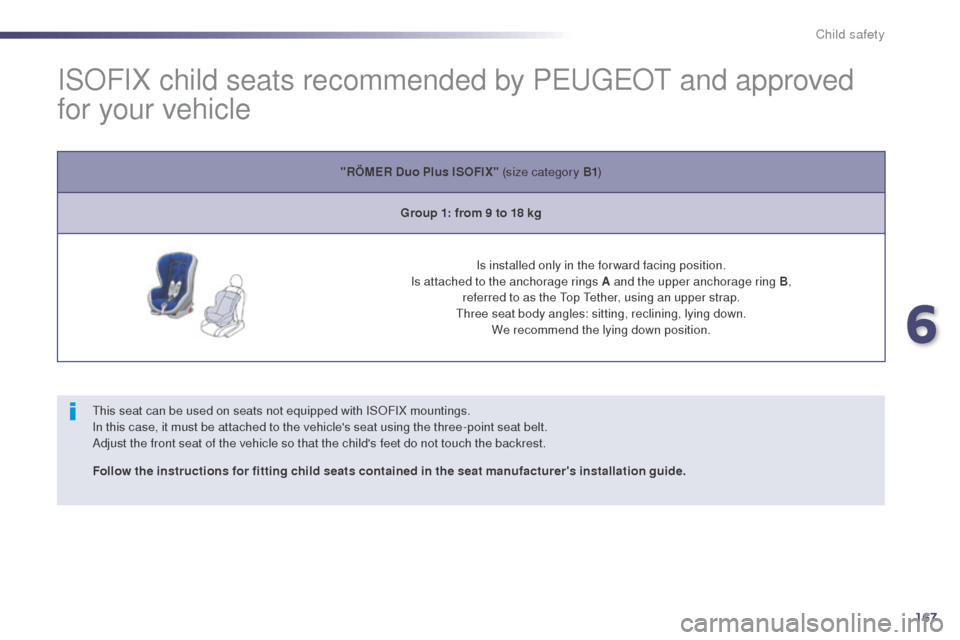2014 Peugeot 508 RXH child seat
[x] Cancel search: child seatPage 166 of 338

164
508RXH_en_Chap06_securite-enfants_ed01-2014
Child seats recommended by PeugeOt
Group 0+: from bir th to 13 kg Group 1: from 9 to 18 kg
L1
"RÖM
eR
/BRI
tA
X Baby-Safe Plus".
Installed in the rearward-facing position. L2
"RÖM
eR D
uo Plus ISOFIX".
Groups 2 and 3: from 15 to 36 kg
L5
" K LI PPA N O pt ima".
From the age of approximately 6 years (22 kg), the booster is used on its own. L6
"RÖM
eR
KIDFIX"
Can be secured using the vehicle's ISOFIX
mountings.
t
h
e child is restrained by the seat belt.
P
e
uge
Ot
offers a range of recommended child seats which are secured using a three point seat belt
.
Child safety
Page 167 of 338

165
508RXH_en_Chap06_securite-enfants_ed01-2014
Installing child seats attached using the seat beltIn accordance with european regulations, this table indicates the options for installing child seats secured using a seat belt and universally approved (a) in
accordance with the weight of the child and the seat in the vehicle.
Weight of the child and indicative age
Seat Under 13 kg
(groups 0 ( b) and 0+)
up t
o approx 1 yearFrom 9 to 18 kg
(g r o u p 1)
1 to 3 years approx From 15 to 25 kg
(group 2)
3 to 6 years approx From 22 to 36 kg
(group 3)
6 to 10 years approx
Front passenger seat ( c)
with height adjustment U (R)
U (R)U (R)U (R)
Front passenger seat (c)
without height adjustment U
UUU
Outer rear seats UUUU
Centre rear seat XXXX
a:
u
niversal child seat, child seat that can be installed in all vehicles using a seat belt.
b:
g
roup 0, from birth to 10 kg. Shell seats and baby carriers cannot be installed in the front passenger
seat. When installed in the 2nd row, they may prevent the use of the other seats.
c: consult the legislation in force in your country before installing your child on this seat.
U:
s
eat suitable for the installation of a child seat secured using a seat belt and universally approved,
"rearward facing" and/or "forward facing".
U (R): same as U , with the vehicle's seat adjusted to the highest position and as far back as possible.
X: seat position not suitable for installation of a child seat for the weight class indicated. Remove and stow the head restraint
before fitting a child seat with backrest
on a passenger seat. Refit the head
restraint when the child seat is
removed.
6
Child safety
Page 168 of 338

166
508RXH_en_Chap06_securite-enfants_ed01-2014
Your vehicle has been approved in accordance
with the latest ISOFIX regulation s.
th
e seats, represented below, are fitted with
regulation ISOFIX mountings.
"ISOFIX" mountings
- two rings A , located between the vehicle
seat back and cushion, indicated by a
label.
th
is ISOFIX mounting system provides fast,
reliable and safe fitting of the child seat in your
vehicle.
th
e ISOFIX child seats are fitted with two
latches which are easily secured on the two
rings A .
Some also have an upper strap which is
attached to ring B .
th
e incorrect installation of a child seat
in a vehicle compromises the child's
protection in the event of an accident.
For information regarding the ISOFIX child
seats which can be installed in your vehicle,
refer to the table showing the locations for
installing ISOFIX child seats.
-
A r
ing B, behind the seat, referred to as the
TOP TETHER for fixing the upper strap.
th
e t
O
P tet
HeR i
s used to secure the upper
strap of child seats that have one.
th
is arrangement reduces forward tipping of
the child seat in the event of a front impact.
to a
ttach this strap, raise the vehicle seat's
head restraint then pass the hook between its
rods. th en fix the hook on ring B and tighten
the upper strap.
ther
e are three rings for each seat.
Follow strictly the instructions for
fitting child seats contained in their
manufacturer's installation guide.
Child safety
Page 169 of 338

167
508RXH_en_Chap06_securite-enfants_ed01-2014
ISOFIX child seats recommended by PeugeOt and approved
for your vehicle
this seat can be used on seats not equipped with ISOFIX mountings.
In this case, it must be attached to the vehicle's seat using the three-point seat belt.
Adjust the front seat of the vehicle so that the child's feet do not touch the backrest. "RÖMER Duo Plus ISOFIX" (size category B1
)
Group 1: from 9 to 18 kg
Is installed only in the forward facing position.
Is attached to the anchorage rings A and the upper anchorage ring B, referred to as the t
o
p t
e
ther, using an upper strap.
th
ree seat body angles: sitting, reclining, lying down.
We recommend the lying down position.
Follow the instructions for fitting child seats contained in the seat manufacturer's installation guide.
6
Child safety
Page 170 of 338

168
508RXH_en_Chap06_securite-enfants_ed01-2014
Baby P2C Mini and its ISOFIX base (size category: E)
Group 0+: from bir th to 13 kg
Installed "rear ward facing" using an ISOFIX base which is attached to the anchorage rings A .
th
e base has a support leg, adjustable for height, which sits on the vehicle's floor.
th
is seat can also be secured with a seat belt. In this case only the seat shell is used.
"Baby P2C Midi" and its ISOFIX base (size categories: D, C, A, B, B1 )
Group 1: from 9 to 18 kg
Installed "rear ward facing" using an ISOFIX base which is attached to the anchorage rings A .
th
e base has a support leg, adjustable for height, which sits on the vehicle's floor.
th
is child seat can also be used "for ward facing".
th
is seat can not be secured with a seat belt.
We recommend that you use the seat in the "rear ward facing" position up to the age of 3 years.
Follow the instructions for fitting child seats contained in the seat manufacturer's installation guide.
th
e ISOFIX BABY P2C base must be installed in a way that the ISOFIX latches 3, 4 and 5 are visible. And the support leg must have 6 holes
visible.
Child safety
Page 171 of 338

169
508RXH_en_Chap06_securite-enfants_ed01-2014
Locations for installing ISOFIX child seats
In accordance with european Regulations, this table indicates the options for installing ISOFIX child seats on seats in the vehicle fitted with ISOFIX
mountings.
In the case of universal and semi-universal ISOFIX child seats, the ISOFIX size category, determined by a letter from A to G , is indicated on the child
seat next to the ISOFIX logo.
Weight of the child / indicative age
Less than 10 kg (group 0)
u
p to approx. 6 months Less than 10 kg
(group 0)
Less than 13 kg (group 0+)
up t
o approx. 1 yearFrom 9 to 18 kg (group 1)
From approx. 1 to 3 years
Type of ISOFIX child seat Shell"rearwards-facing"
"rearwards-facing""forwards-facing"
ISOFIX size categor y F G C D E C D A B B1
Front passenger seat Not Isofix
Outer rear seats XIL- SU IL- SU IUF
IL- SU
Centre rear seat Not Isofix
I UF: seat suitable for the installation of an I sofix Universal seat, " For wards-facing" secured using the top belt.
IL- SU: seat suitable for the installation of an I sofix Semi-Universal seat either:
-
"
rear wards-facing" fitted with a top belt or a stay,
-
"
for wards-facing" fitted with a stay,
-
a s
hell seat fitted with an upper strap or a stay.
For advice on securing of the top belt, refer to the paragraph "Isofix mountings".
X: seat not suitable for the installation of a child seat or shell for the weight group indicated.
6
Child safety
Page 172 of 338

170
508RXH_en_Chap06_securite-enfants_ed01-2014
Child seats
the incorrect installation of a child seat in a
vehicle compromises the child's protection in
the event of an accident.
Check that there is no seat belt or seat belt
buckle under the child seat as this could
destabilise it.
Remember to fasten the seat belts or the
child seat harnesses keeping the slack in
relation to the child's body to a minimum,
even for short journeys.
For the installation of a child seat using a
seat belt, ensure that this is well tensioned
on the child seat and that it is holding the
child seat firmly against the seat of your
vehicle. If your front passenger seat is
adjustable, move it forward if necessary.
At the rear seats, always leave sufficient
space between the front seat and:
-
a r
ear ward facing child seat,
-
t
he feet of a child seated in a for ward
facing child seat.
For this, move the front seat for ward and if
necessary straighten its backrest.
Recommendations
As a safety precaution, do not leave:
- o ne or more children alone and
unsupervised in a vehicle,
-
a c
hild or an animal in a vehicle which
is exposed to the sun, with the windows
closed,
-
t
he keys within reach of children inside
the vehicle.
to p
revent accidental opening of the doors,
use the "Child lock".
ta
ke care not to open the rear windows by
more than one third.
to p
rotect young children from the rays of
the sun, fit side blinds on the rear windows.
th
e chest part of the seat belt must be
positioned on the child's shoulder without
touching the neck.
en
sure that the lap part of the seat belt
passes correctly over the child's thighs.
P
e
uge
Ot
recommends the use of a booster
seat which has a back, fitted with a seat belt
guide at shoulder level.
For optimum installation of the "forward
facing" child seat, ensure that the back of
the child seat is as close as possible to the
backrest of the vehicle's seat, or in contact
if possible
th
e head restraint must be removed before
installing a child seat with a backrest on the
passenger seat.
en
sure that the head restraint is stowed or
attached securely so that it is not thrown
around the vehicle in the event of sharp
braking.
Refit the head restraint as soon as the child
seat is removed.Children at the front
the legislation on carrying a child on the
front passenger seat is specific to each
country. Refer to the legislation in force in
the country in which you are driving.
Deactivate the passenger's front airbag
when a "rear ward facing" child seat is
installed on the front passenger seat.
Otherwise, the child would risk being
seriously injured or killed if the airbag were
deployed.
Installing a booster
cushion
Child safety
Page 184 of 338

182
508RXH_en_Chap07_securite_ed01-2014
the driver must ensure that passengers use
the seat belts correctly and that they are all
restrained securely before setting off.
Wherever you are seated in the vehicle,
always fasten your seat belt, even for short
journeys.
Do not interchange the seat belt buckles as
they will not fulfil their role fully.
th
e seat belts are fitted with an inertia reel
permitting automatic adjustment of the
length of the strap to your size.
t
h
e seat belt
is stowed automatically when not in use.
Before and after use, ensure that the seat
belt is reeled in correctly.
th
e lower part of the strap must be
positioned as low as possible on the pelvis.
th
e upper part must be positioned in the
hollow of the shoulder.
th
e inertia reels are fitted with an automatic
locking device which comes into operation in
the event of a collision, emergency braking
or if the vehicle rolls over. You can release
the device by pulling firmly on the strap and
releasing it so that it reels in slightly.Recommendations for children
use a suitable child seat if the passenger is
less than 12 years old or shorter than one
and a half metres.
Never use the same seat belt to secure more
than one person.
Never allow a child to travel on your lap.
In order to be effective, a seat belt must:
-
b
e tightened as close to the body as
possible,
-
b
e pulled in front of you with a smooth
movement, checking that it does not
twist,
-
b
e used to restrain only one person,
-
n
ot bear any trace of cuts or fraying,
-
n
ot be converted or modified to avoid
affecting its performance.
In accordance with current safety
regulations, for all repairs on your vehicle,
go to a qualified workshop with the skills
and equipment needed, which a P
e
uge
Ot
dealer is able to provide.
Have your seat belts checked regularly by a
P
e
uge
Ot
dealer or a qualified workshop,
particularly if the straps show signs of
damage.
Clean the seat belt straps with soapy
water or a textile cleaning product, sold by
P
e
uge
Ot d
ealers.
After folding or moving a seat or rear bench
seat, ensure that the seat belt is positioned
and reeled in correctly.
In the event of an impact
Depending on the nature and
seriousness of the impact , the
pretensioning device may be deployed
before and independently of the airbags.
Deployment of the pretensioners is
accompanied by a slight discharge of
harmless smoke and a noise, due to the
activation of the pyrotechnic cartridge
incorporated in the system.
In all cases, the airbag warning lamp comes
on.
Following an impact, have the seat belts
system checked, and if necessary replaced,
by a P
e
uge
Ot
dealer or a qualified
workshop.
In the event of an accident, the high voltage
is disconnected automatically.
Safety